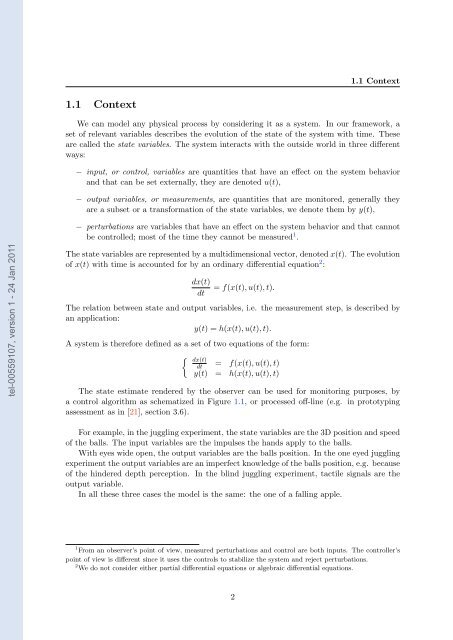Adaptative high-gain extended Kalman filter and applications
Adaptative high-gain extended Kalman filter and applications
Adaptative high-gain extended Kalman filter and applications
You also want an ePaper? Increase the reach of your titles
YUMPU automatically turns print PDFs into web optimized ePapers that Google loves.
tel-00559107, version 1 - 24 Jan 2011<br />
1.1 Context<br />
1.1 Context<br />
We can model any physical process by considering it as a system. In our framework, a<br />
set of relevant variables describes the evolution of the state of the system with time. These<br />
are called the state variables. The system interacts with the outside world in three different<br />
ways:<br />
− input, or control, variables are quantities that have an effect on the system behavior<br />
<strong>and</strong> that can be set externally, they are denoted u(t),<br />
− output variables, or measurements, are quantities that are monitored, generally they<br />
are a subset or a transformation of the state variables, we denote them by y(t),<br />
− perturbations are variables that have an effect on the system behavior <strong>and</strong> that cannot<br />
be controlled; most of the time they cannot be measured 1 .<br />
The state variables are represented by a multidimensional vector, denoted x(t). The evolution<br />
of x(t) with time is accounted for by an ordinary differential equation 2 :<br />
dx(t)<br />
dt<br />
= f(x(t),u(t),t).<br />
The relation between state <strong>and</strong> output variables, i.e. the measurement step, is described by<br />
an application:<br />
y(t) =h(x(t),u(t),t).<br />
A system is therefore defined as a set of two equations of the form:<br />
� dx(t)<br />
dt = f(x(t),u(t),t)<br />
y(t) = h(x(t),u(t),t)<br />
The state estimate rendered by the observer can be used for monitoring purposes, by<br />
a control algorithm as schematized in Figure 1.1, or processed off-line (e.g. in prototyping<br />
assessment as in [21], section 3.6).<br />
For example, in the juggling experiment, the state variables are the 3D position <strong>and</strong> speed<br />
of the balls. The input variables are the impulses the h<strong>and</strong>s apply to the balls.<br />
With eyes wide open, the output variables are the balls position. In the one eyed juggling<br />
experiment the output variables are an imperfect knowledge of the balls position, e.g. because<br />
of the hindered depth perception. In the blind juggling experiment, tactile signals are the<br />
output variable.<br />
In all these three cases the model is the same: the one of a falling apple.<br />
1 From an observer’s point of view, measured perturbations <strong>and</strong> control are both inputs. The controller’s<br />
point of view is different since it uses the controls to stabilize the system <strong>and</strong> reject perturbations.<br />
2 We do not consider either partial differential equations or algebraic differential equations.<br />
2

















